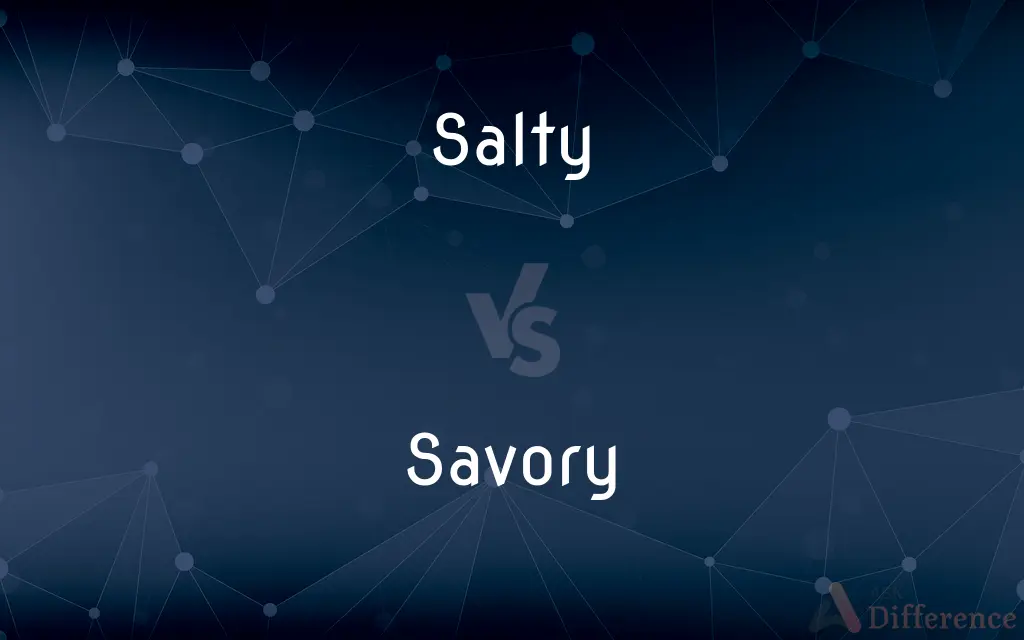Salty vs. Savory — What's the Difference?
By Maham Liaqat & Fiza Rafique — Updated on March 26, 2024
Salty flavors are primarily characterized by the presence of salt, enhancing taste, whereas savory, or umami, adds depth and complexity, often found in meats, cheeses, and vegetables.

Difference Between Salty and Savory
Table of Contents
ADVERTISEMENT
Key Differences
Salty is one of the five basic tastes and is primarily characterized by the presence of salt. It's a flavor that enhances the taste of food and is essential for balancing and bringing out other flavors. On the other hand, savory, also known as umami, is a taste that is often described as meaty or broth-like. It is associated with foods that contain high levels of glutamates, such as meats, cheeses, and certain vegetables.
While salt is often added to foods to achieve a salty taste, savory flavors naturally occur in foods that are rich in amino acids and nucleotides, such as mushrooms, tomatoes, and aged cheeses. Savory dishes often have a complexity that goes beyond mere saltiness, providing a depth of flavor that can make a dish more satisfying.
In cooking, the salty taste is used to season and enhance the flavor of food, making it more palatable. Salt can draw out moisture, preserve food, and even impact the texture. Savory flavors, however, are often sought after for their ability to create a full-bodied and rich taste experience, adding a layer of complexity that enhances the overall dish without necessarily adding saltiness.
The distinction between salty and savory is crucial in culinary arts and food science. While both can enhance a dish, they do so in different ways. Salty flavors can make a dish more appetizing by highlighting other flavors, whereas savory flavors add a sense of richness and depth that can make a dish feel more substantial and satisfying.
Salty foods are often simple to identify, as the taste of salt is unmistakable. Savory flavors, though, can be more nuanced, involving a combination of ingredients and cooking techniques to achieve the desired umami effect. This complexity makes savory dishes particularly appealing to those with a sophisticated palate.
ADVERTISEMENT
Comparison Chart
Basic Taste
One of the five basic tastes, primarily from salt.
One of the five basic tastes, often described as meaty or broth-like.
Source
Primarily from the addition of salt.
Naturally occurring in foods rich in glutamates and nucleotides.
Flavor Profile
Enhances and balances other flavors.
Adds depth, richness, and complexity to dishes.
Cooking Use
Used to season and preserve food.
Creates a satisfying and full-bodied taste.
Examples
Salted snacks, pickles.
Meat dishes, cheese, mushrooms, tomatoes.
Compare with Definitions
Salty
Preservation.
Salty conditions in cured meats help in their preservation.
Savory
Culinary Depth.
Umami enhances the overall richness of the dish without adding salt.
Salty
Enhances Flavors.
A pinch of salt can transform a bland soup into a savory delight.
Savory
Complex Flavor.
The umami flavor of the broth added depth to the stew.
Salty
Ubiquitous in Snacks.
Salty snacks like chips are popular for their addictive taste.
Savory
Sophisticated Palate.
Savory dishes are appreciated by those seeking a complex flavor profile.
Salty
Crucial for Balance.
Salt is essential in baking to balance the sweetness.
Savory
Richness.
Parmesan adds a savory quality to pasta dishes.
Salty
Basic Taste.
The salty flavor of the popcorn was perfectly balanced.
Savory
Natural Occurrence.
Mushrooms have a naturally savory, umami-rich flavor.
Salty
Of, containing, or seasoned with salt.
Savory
Appetizing to the taste or smell
A savory stew.
Salty
Suggestive of the sea or sailing life.
Savory
Piquant, pungent, or salty to the taste; not sweet.
Salty
Witty; pungent; earthy
Salty humor.
Savory
Morally respectable; inoffensive
A past that was scarcely savory.
Salty
Tasting of salt.
Savory
A dish of pungent taste, such as anchovies on toast or pickled fruit, sometimes served in Great Britain as an hors d'oeuvre or instead of a sweet dessert.
Salty
Containing salt.
Savory
An annual Mediterranean aromatic herb (Satureja hortensis) of the mint family, having pale lavender to white flowers. Also called summer savory.
Salty
; provocative; earthy.
Savory
A related Mediterranean aromatic perennial herb (Satureja montana), having white or pink flowers. Also called winter savory.
Salty
(figuratively) Experienced, especially used to indicate a veteran of the naval services; salty dog (from salt of the sea).
Savory
The leaves of either of these plants, used as seasoning.
Salty
(slang) Irritated, annoyed, angry, bitter, bitchy.
Savory
Tasty, attractive to the palate.
The fine restaurant presented an array of savory dishes; each was delicious.
Salty
(linguistics) Pertaining to the Sardinian language and those dialects of Catalan, spoken in the Balearic Islands and along the coast of Catalonia, that use definitive articles descended from the Latin self instead of the Latin that.
Savory
Salty and/or spicy, but not sweet.
The mushrooms, meat, bread, rice, peanuts and potatoes were all good savory foods.
Salty
Somewhat salt; saltish.
Savory
Umami, modern
The savory rabbit soup contrasted well with the sweet cucumber sandwiches with jam.
Salty
Engagingly stimulating or provocative;
A piquant wit
Salty language
Savory
(figuratively) Morally or ethically acceptable.
Readers are to be warned that quotations in this chapter contain some not so savory language.
Salty
Containing salt;
A saline solution
Salty tears
Savory
(American spelling) A savory snack.
Salty
One of the four basic taste sensations; like the taste of sea water
Savory
Any of several Mediterranean herbs, of the genus Satureja, grown as culinary flavourings.
Savory
The leaves of these plants used as a flavouring.
Savory
Pleasing to the organs of taste or smell.
The chewing flocksHad ta'en their supper on the savory herb.
Savory
An aromatic labiate plant (Satureia hortensis), much used in cooking; - also called summer savory.
Savory
Any of several aromatic herbs or subshrubs of the genus Satureja having spikes of flowers attractive to bees
Savory
Dwarf aromatic shrub of Mediterranean regions
Savory
Either of two aromatic herbs of the mint family
Savory
An aromatic or spicy dish served at the end of dinner or as an hors d'oeuvre
Savory
Morally respectable or inoffensive;
A past that was scarcely savory
Savory
Having an agreeably pungent taste
Savory
Pleasing to the sense of taste
Common Curiosities
Can a food be both salty and savory?
Yes, many dishes combine both salty and savory elements for a more complex flavor profile.
What defines a savory taste?
Savory, or umami, is a rich and complex taste often described as meaty or broth-like, found in cooked or fermented foods.
What foods are high in umami?
Foods high in umami include meats, cheeses, mushrooms, tomatoes, and soy products.
Can reducing salt in a diet affect taste preferences?
Reducing salt can initially affect taste preferences, but many find that they enjoy the natural flavors of food more over time.
What role does umami play in vegetarian cuisine?
Umami plays a crucial role in vegetarian cuisine by adding meatiness and depth to dishes without the use of meat.
How does salt enhance the flavor of food?
Salt enhances flavor by balancing and highlighting other tastes, making the food more palatable.
How can I add savory flavors to my cooking?
Adding ingredients like mushrooms, ripe tomatoes, soy sauce, and aged cheeses can increase a dish's savory qualities.
Is umami a natural taste?
Yes, umami is a natural taste found in foods that are rich in glutamates and nucleotides.
What is salty taste?
Salty taste is one of the basic tastes, arising from the presence of salt in food.
Why is savory taste important in cooking?
Savory taste adds depth, richness, and complexity, making dishes more satisfying.
Share Your Discovery

Previous Comparison
Fox vs. Kitsune
Next Comparison
Hallway vs. HallAuthor Spotlight
Written by
Maham LiaqatCo-written by
Fiza RafiqueFiza Rafique is a skilled content writer at AskDifference.com, where she meticulously refines and enhances written pieces. Drawing from her vast editorial expertise, Fiza ensures clarity, accuracy, and precision in every article. Passionate about language, she continually seeks to elevate the quality of content for readers worldwide.














































